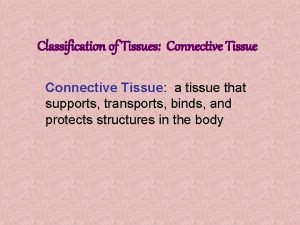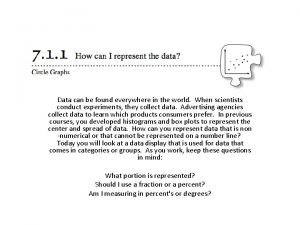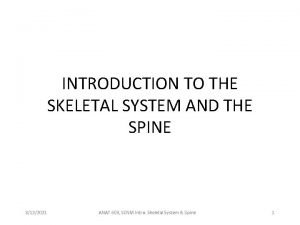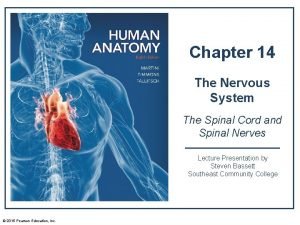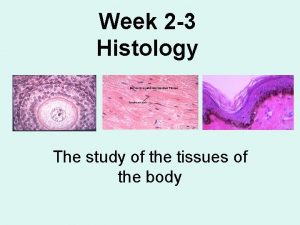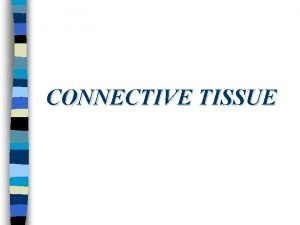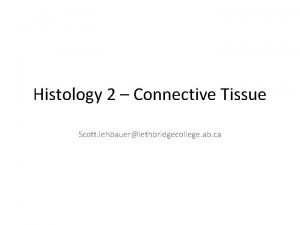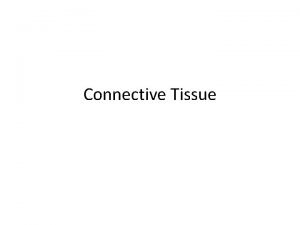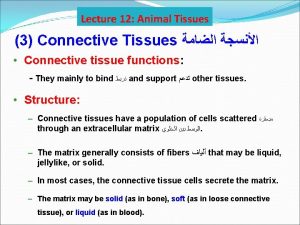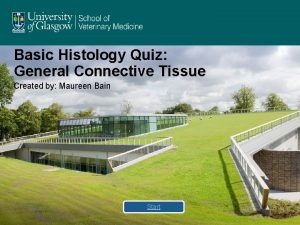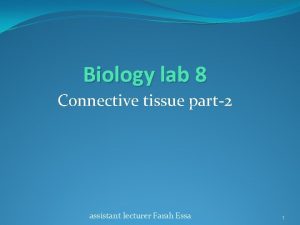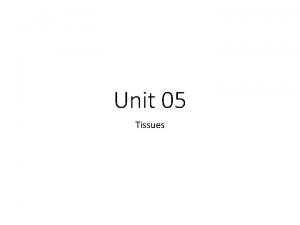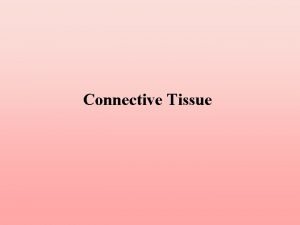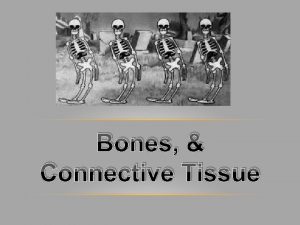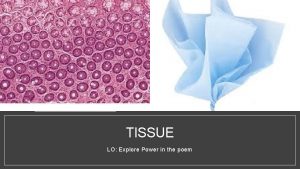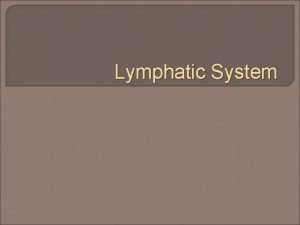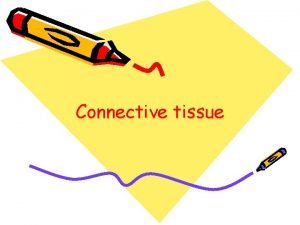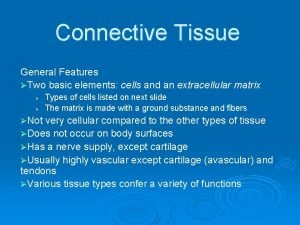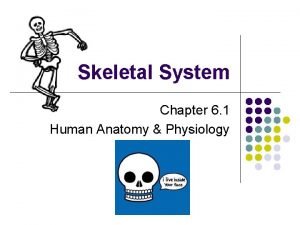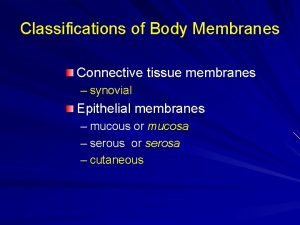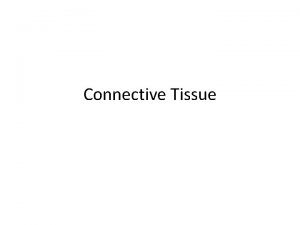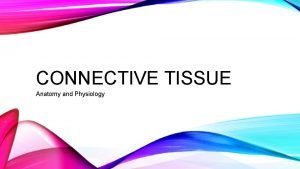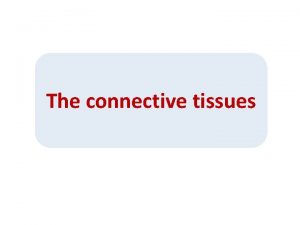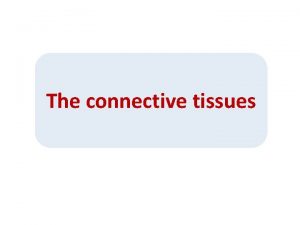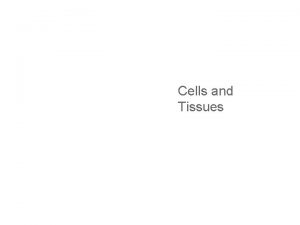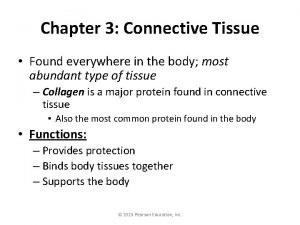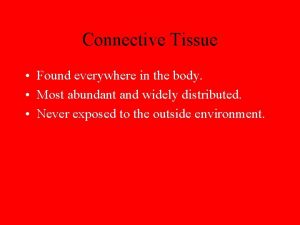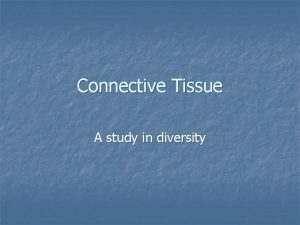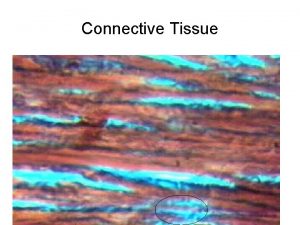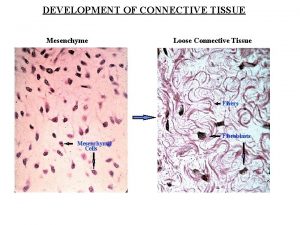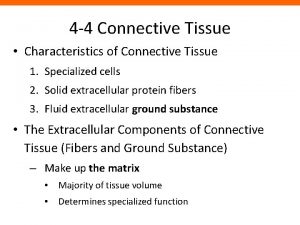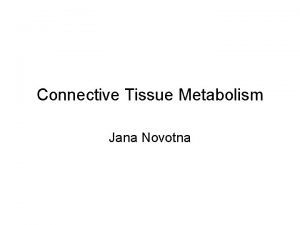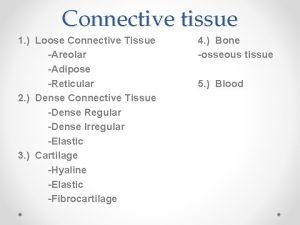Connective Tissue Anatomy Connective Tissue Found EVERYWHERE in




























- Slides: 28

Connective Tissue Anatomy

Connective Tissue Found EVERYWHERE in the body p Most abundant p 4 main types: p n n Connective tissue proper (fat) Cartilage Bone tissue Blood

Common Characteristics p Common origin n p Degrees of vascularity n p Arise from mesenchyme (embryonic tissue) Cartilage is avascular…etc. Extracellular matrix n Separates living cells of the tissue (bear weight, withstand tension, endure abuse)

Structural Elements p Ground substance n n n Unstructured Serves as glue (allows connective tissue cells to attach themselves to a matrix) Holds a lot of fluids p Nutrients can diffuse between blood and cells

Structural Elements p Fibers n n n Collagen (tough, resist stress, stronger than steel!) Elastic (stretch rubberband) Reticular (support tissues of organs, allow more “give” than collagen)

Types of Connective Tissue p Embryonic connective tissue: Mesenchyme n Gel like Ground substance n Give rise to all connective tissue types n Primarily in embryo n

Types of Connective Tissue p Loose connective Tissue: Areolar n Gel like n n Wraps and cushions organs Macrophages in here help with inflammation Holds fluid in n Under epithelial cells n

Types of Connective Tissue p Loose connective tissue: adipose n n n Matrix is areolar Closely packed together Nucleus pushed to side by fat droplets n Energy: long term Insulate Support/protect n Under skin, around kidneys/eyeballs n n

Types of Connective Tissue p Loose connective tissue: reticular n Network of reticular fibers in a loose ground substance n Form a soft skeleton that supports other cells (white blood cells, macrophages) n Lymphoid organs lymph nodes, bone marrow, spleen

Types of Connective Tissue p Dense connective tissue: dense regular n Parallel collagen fibers n n Attaches muscle to bone Attaches bone to bone Withstands stress n Tendons, ligaments n

Types of Connective Tissue p Dense connective tissue: dense irregular n Irregularly arranged collagen fibers n Withstands great tension, strong, can move in many directions n Skin, digestive tract, joints

Types of Connective Tissue p Cartilage: hyaline n n Firm Chondroblasts produce matrix p Mature chondroblasts are chondrocytes n Support/reinforces, cushioning, resist compressive stress n Embryonic skeleton, part of ribs, nose, trachea, larynx

Types of Connective Tissue p Cartilage: elastic n More elasticity than hyaline n Maintains shape/structure n Supports external ear

Types of Connective Tissue p Cartilage: fibrocartilage n Thick collagen fibers n Absorbs compressive shock n Intervertebral discs, discs of knee joint

Types of Connective Tissue p Bone: osseous tissue n Hard, calcified, a lot of collagen, vascular n Support, protect, lever for muscles to act on, stores calcium/minerals, marrow produces blood n Bones

Types of Connective Tissue p Blood n Red and white blood cells in a fluid (plasma) n Transport gases, nutrients, wastes n Contained within blood vessels


Nervous Tissue p Nervous tissue n Neurons n Transmit electrical impulses for sensory receptors to effectors n Brain, spinal cord, nerves


Muscle Tissue p Skeletal muscle n Long, cylindrical , multi-nucleated, striated n Voluntary movement, locomotion, facial expression n Attach to bones or occasionally skin


Muscle Tissue p Cardiac Muscle n Branching, striated, uninucleated, junctions called interalated discs n As it contracts it propels blood, involuntary n Walls of heart

Muscle Tissue p Smooth Muscle n Spindle shaped, nuclei is centered, forms sheets n Propels substances along internal passage (urine, baby, food), involuntary n Walls of hollow organs

Tissue Repair p 1. Inflammation n n Tissue DRAMA! Injured cell releases chemicals Chemicals cause tissue to dilate more permeable White blood cells/plasma/antibodies seep into area Construct a clot

Tissue Repair p 2. Organization restores blood supply n n Clot is replaced by granulation tissue (delicate pink tissue that contains capillaries) Granulation tissue bleeds easily (pick at a scab) Produce growth factors Becomes scar tissue (highly resistant to infection bacteria inhibiting substances)

Tissue Repair p Regeneration/fibrosis n n Epithelium regenerates Scar may be visible or invisible


http: //classes. midlandstech. edu/carterp/ Courses/bio 210/chap 04. html
 Everywhere you go everywhere you look
Everywhere you go everywhere you look Where is areolar connective tissue found
Where is areolar connective tissue found Regular vs irregular dense connective tissue
Regular vs irregular dense connective tissue Dense regular connective tissue tendon
Dense regular connective tissue tendon Information can be seen everywhere
Information can be seen everywhere What are the 11 criteria for lupus
What are the 11 criteria for lupus Embryonic connective tissue
Embryonic connective tissue Adipose tissue
Adipose tissue Connective tissue layer
Connective tissue layer Apical layer
Apical layer Dense connective tissue
Dense connective tissue Fibroelastic connective tissue
Fibroelastic connective tissue Reticular connective tissue
Reticular connective tissue Cartilage hyaline function
Cartilage hyaline function Hyaline cartilage cells
Hyaline cartilage cells Function of animal tissue
Function of animal tissue Connective tissue histology quiz
Connective tissue histology quiz Que imagem é essa
Que imagem é essa Simple squamous epithelium
Simple squamous epithelium Dense connective tissue
Dense connective tissue Fibrocartilage connective tissue
Fibrocartilage connective tissue Tissue structure poem
Tissue structure poem Lymphatic capillaries are thin walled closed ended tubes
Lymphatic capillaries are thin walled closed ended tubes Dense connective tissue definition
Dense connective tissue definition Areolar tissue
Areolar tissue Specialized connective tissue
Specialized connective tissue Connective tissue membrane
Connective tissue membrane Specialized connective tissue blood
Specialized connective tissue blood Classification of body membranes
Classification of body membranes


